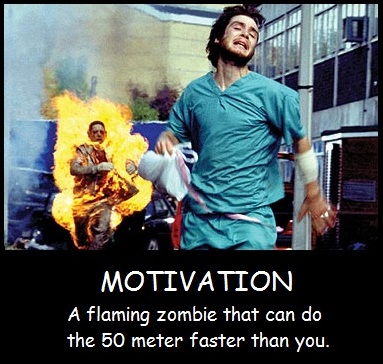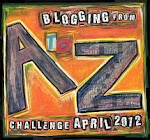More Zombie Brainstorming!
As I blogged about a couple or so days ago, my son Giant Boy and I decided to add some survival horror to Go Fer Yer Gun! (which is published by Beyond Belief Games). Not wanting the stereotypical Romeroid zombies, there was some brainstorming, and these five traits are what fell from the brainclouds:
Trait 1: The “zombies” are created by a bloodborne pathogen that infects a human host. The host’s lymph nodes swell into buboes. These buboes fill with a mixture of blood, pus, and live virus. Not only can they pop if roughly handled, the virus changes the host’s body so that the host can vent its buboes’ contents via the mouth and nose.
Trait 2: The infected do not respirate the way humans do. Their lungs do not serve any particular purpose. More physiological changes, however, give an infected the ability to voluntarily control its thoracic diaphragm. By contracting or relaxing this muscle, an infected can inhale or exhale, permitting it produce limited vocalizations. The infected cannot speak, except perhaps single syllable words that would be more hissed than articulated, but they can growl, moan, et cetera.
Trait 3: Further physiological changes alter bone structure and density. The proximal and distal phalanges fuse (N.B. limited finger dexterity), and the fused bones grows into something very much like a spike. Since the bones are denser as a whole, the infected is more durable and less suspectible to injury.
Trait 4: The infected’s brain changes as well. It enters a hyper-adrenaline state which constantly floods the infected’s body with this powerful hormone. At the same time, the nervous system is less sensitive to pain and fatigue.
Trait 5: The infected kill and eat the non-infected because uninfected human tissues contain a variety of hormones which nourish the virus. Chief among the hormones that the infected crave are arenaline and cortisol, the hormones that trigger the flight-or-fight response.
Next up, we need to look at how the heroes (meaning the PCs) will survive this apocalypse. As a player, I don’t like having to make up a new character every session or two. As a GM, I don’t like having to figure out how to introduce replacement PCs to the rest of the group. Something needs to be done that mitigates hero death but at the same time preserves the horror element of the survival horror genre.
GFYG! uses a hit point system to track character health and damage. Heroes heal one hit point per day. At 0 hit points, a hero passes out. Below 0 hit points means the hero is seriously injured and bleeding out at a rate of 1 hit point per round. When -10 hit points is reached, the hero dies. A critical hit might occur on a natural 20 attack roll. A confirmation roll, essentially a second attack roll, that meets the target number means the attack is critical. All critical hits inflict double damage.
So far, there’s nothing all that surprising here. These rules are pretty much old hat. They don’t, however, seem well-suited to survival horror. Let’s tweak things, taking inspiration from another old hat idea.
Bruises & Wounds
At each level in standard GFYG!, a hero gets 1 Hit Die worth of hit points. The hero’s Constitution modifier is added to the Hit Die result to determine hit points at that level. At 1st level, a hero gets maximum hit points. For our survival horror version of GFYG!, hit points don’t work quite this way. At each level, the hero’s hit points (not counting Constitution modifier) are divided between Bruises and Wounds. If hit points generated are an odd number, Bruises gets rounded up, and Wounds gets rounded down. The hero’s Constitution modifier gets added to Bruises only.
For example, Tex McGraw is a 1st-level gunslinger with a 14 Constitution (+2 modifier). Tex gets maximum hit points at 1st level, or 10 hit points. These are divided by two, and his Constitution modifier is added to Bruises. Thus, Tex has 7 Bruises and 5 Wounds. (Well, not that he actually has that many bruises and wounds; those are points, not injuries.) Tex survives to 2nd-level. (Yippee-ki-yay, Tex!) He rolls 1d10 and gets a 7. This yields 6 more Bruises (included Constitution modifier) and 3 more Wounds, bring Tex’s totals to 13 Bruises and 8 Wounds.
Since hit points (and related systems, such as Bruises and Wounds) are abstractions wherein damage doesn’t necessarily mean gushing wounds, here’s how this modified system works. When Tex gets hit (shot, stabbed, punched, bitten, et cetera), he takes damage to Bruises first. This represents minor bumps, scrapes, pulled muscles, and so forth. When Bruises are gone, Tex takes damage directly to Wounds. These represent serious injuries. A successful critical hit deals half damage to Bruises and half damage directly to Wounds.
A hero still becomes unconscious at 0, but 0 Wounds instead of 0 hit points. He starts to bleed out if reduced to -1 Wounds, and dies at -10 Wounds.
Bruises heal much more quickly than Wounds. A hero recovers his character level plus Constitution modifier in Bruises every 8 hours of rest. Wounds, however, still heal at the much slower rate as normal for GFYG!.
Under most circumstances, special attacks (such as infection from an infected’s bite) do not affect a hero unless the attack does damage directly to Wounds. An infected’s bite that only causes Bruises doesn’t potentially turn a hero into a frothing-at-the-mouth homicidal cannibal. This gives heroes a “buffer” during which they can fight the infected without risk of infection (barring critical hits or being splattered by an infected’s head being blasted apart by a shotgun). Eventually, a pitched battle against a mob of the infected is a losing proposition. Those Bruises are going to build up until a hero finally suffers Wound damage.
Survival of the Fittest?
GFYG! uses the tried and true 3d6 arranged to suit preferences method of attribute generation. This fits survival horror, and I see little reason to change it. One of the themes of survival horror comes from naturalist literature, such as the stories of Jack London. Check out his classic “To Build a Campfire”. Nature doesn’t care about virtue. It doesn’t mete out justice or distinguish between the deserving and the undeserving. Nature kills indiscriminately, and sometimes no amount of native ability or acquired skill makes much difference. Sure, a character with a 16 Strength has a survival advantage over a character with a 6 Strength, but it’s not a guarantee of success.
During the A to Z blogging challenge, I wrote about using exploding dice with the Pathfinder Roleplaying Game. I like this idea. It can be linked to character strengths while at the same time helps represent the fickle whims of circumstance that don’t give a hoot that the hero is the hero. In the next post on this topic, we’ll look at adding an exploding dice mechanic to GFYG! that takes into account that game’s system of primary, secondary, and tertiary attributes.
I’ll also look at GFYG!‘s character classes to see if maybe there needs to be some changes to the way they work in a survival horror game.
Until then, don’t get bit!
 My son Giant Boy and I watched
My son Giant Boy and I watched 

